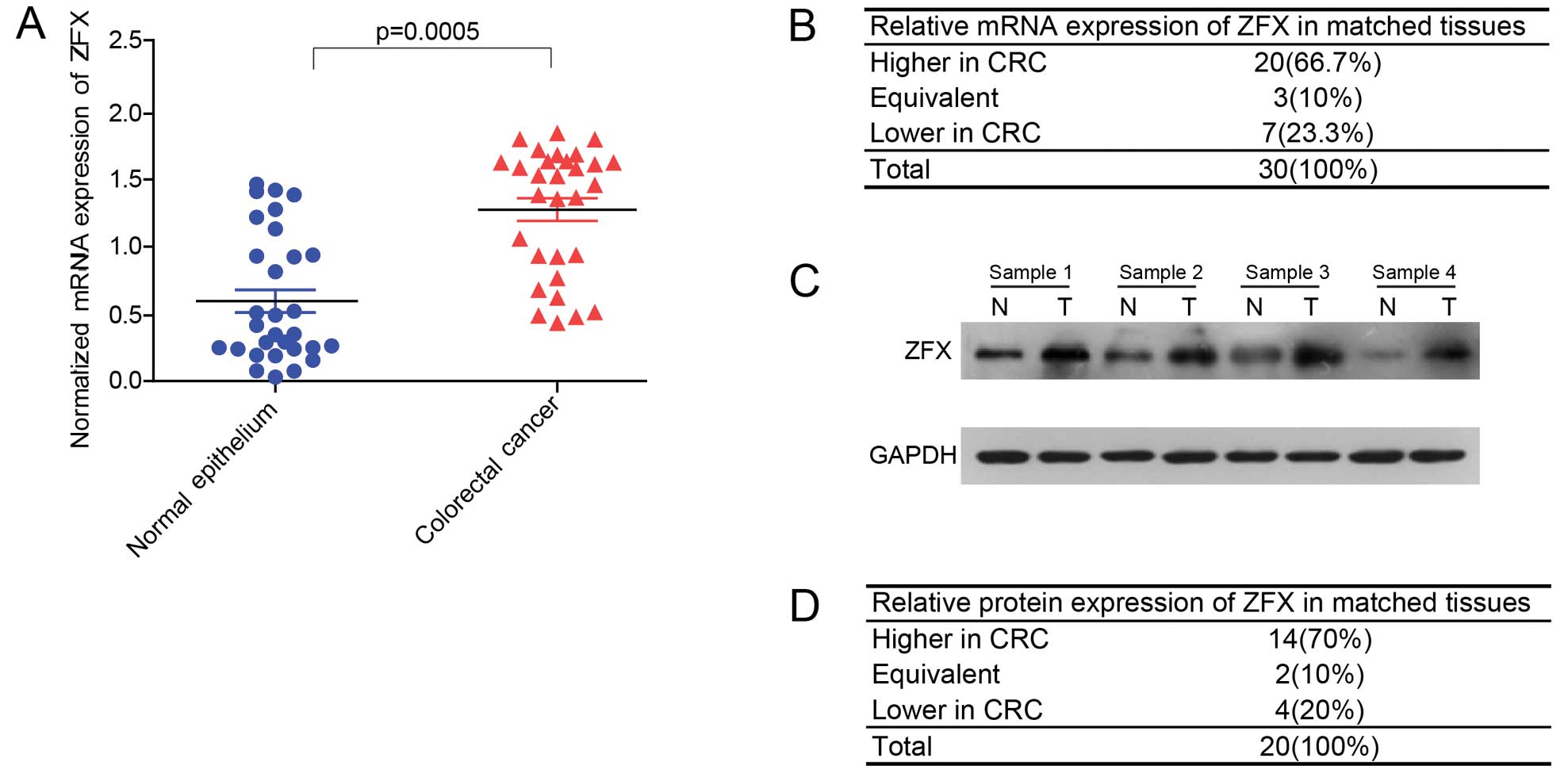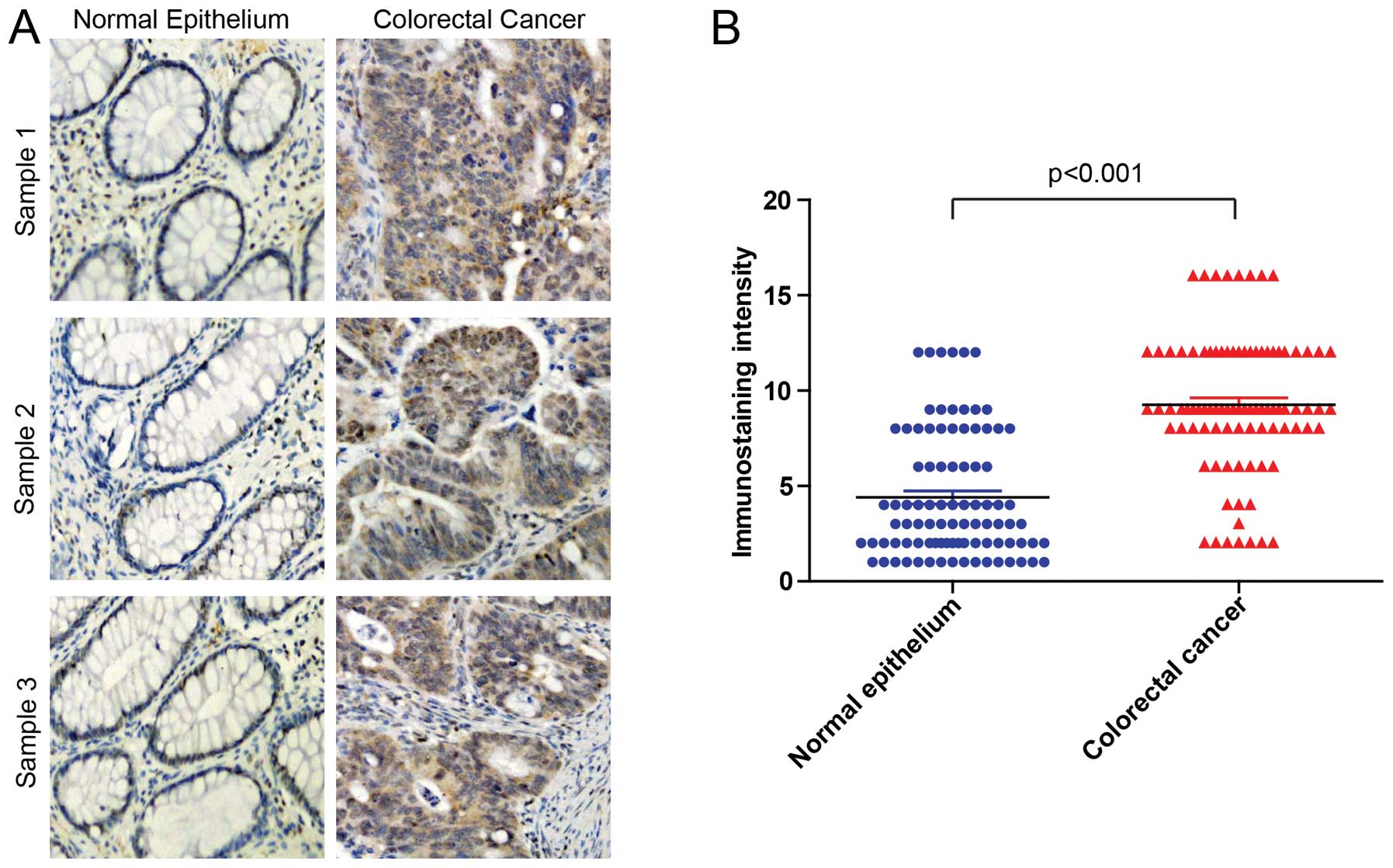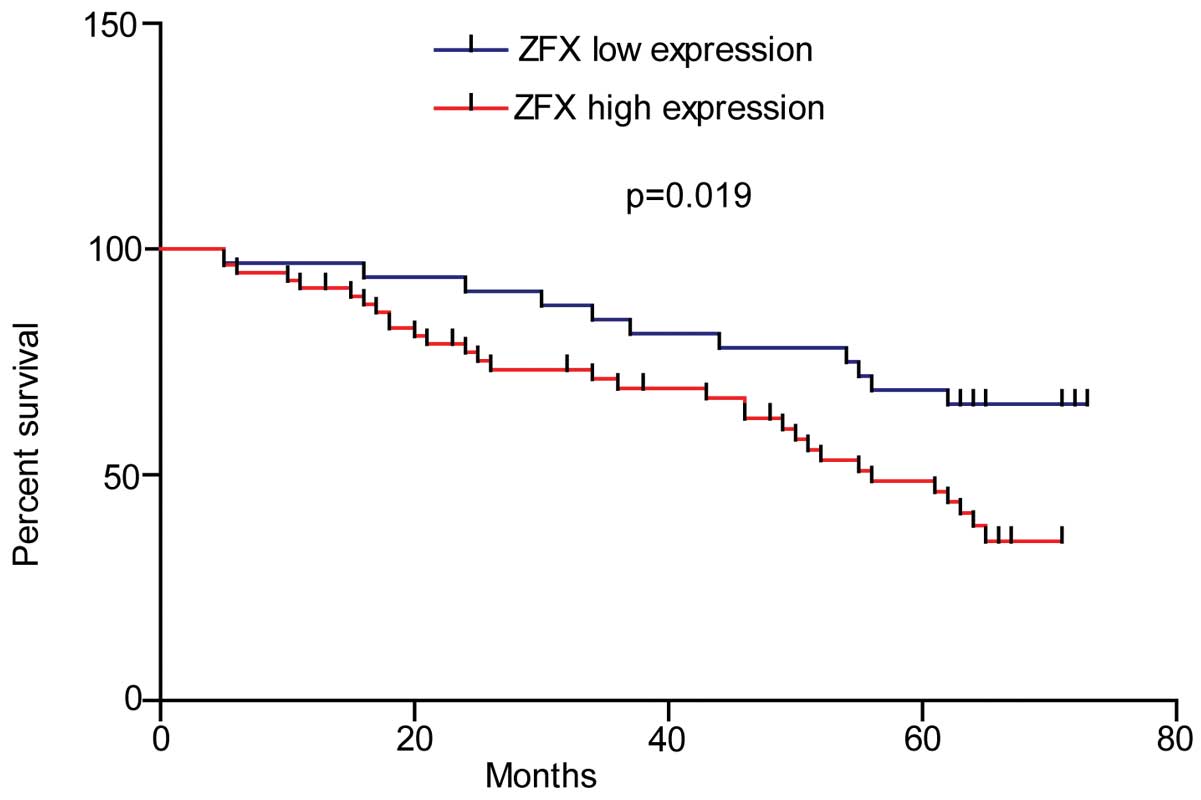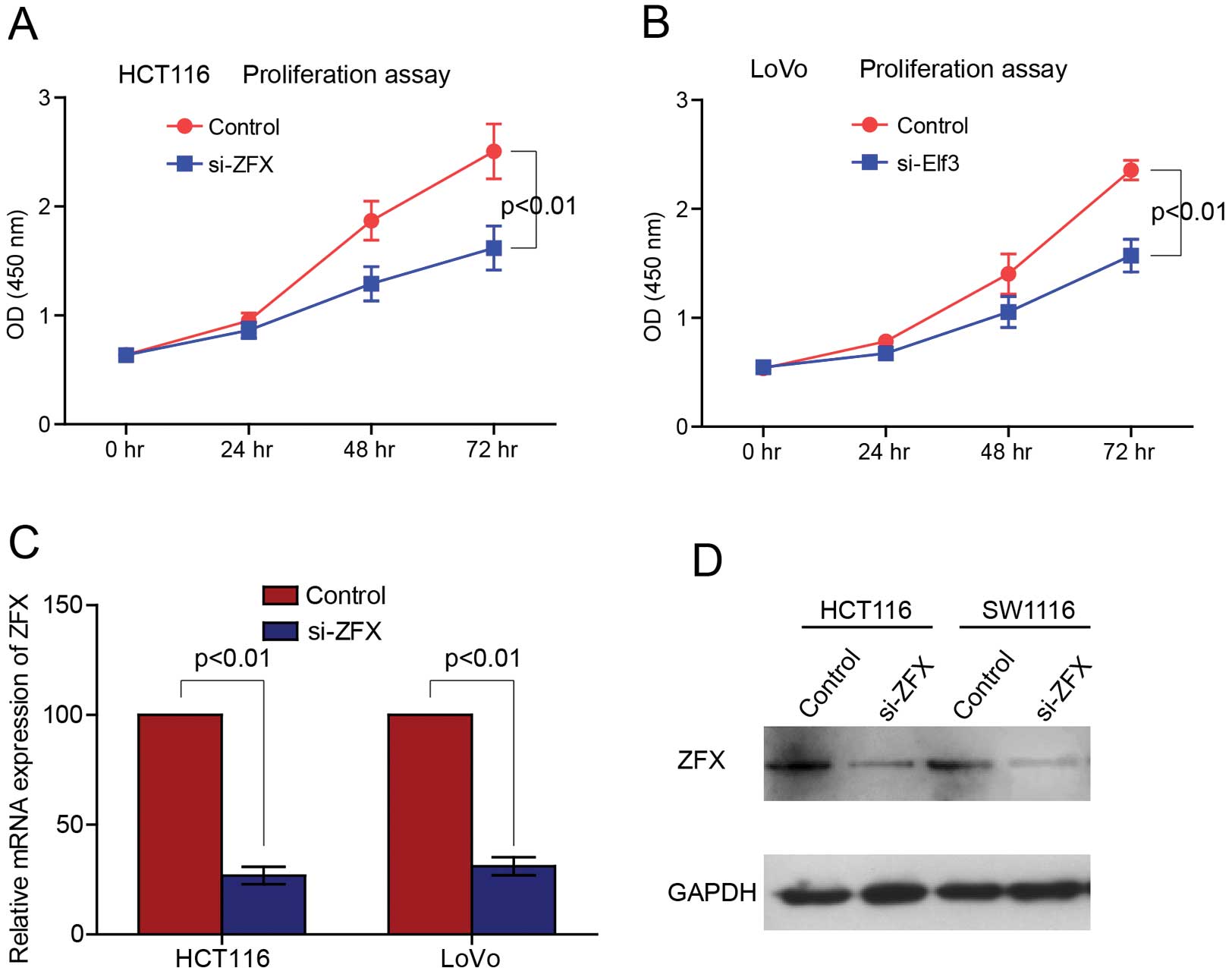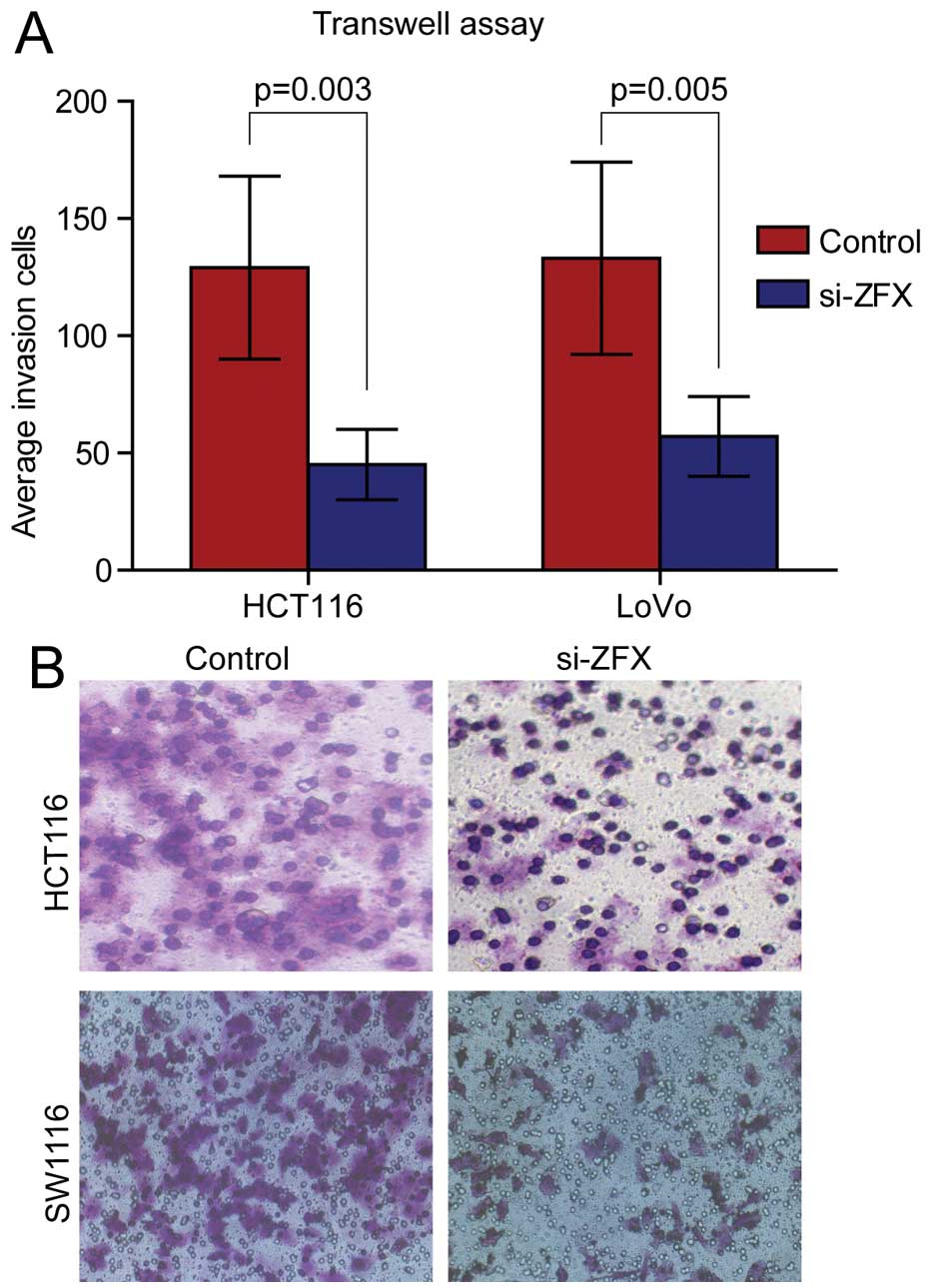Introduction
Colorectal cancer (CRC) is the third most common
type of cancer worldwide, with over 1.4 million new cancer cases
and 50,000 mortalities reported in 2013 (1). However, the biological and molecular
mechanisms underlying CRC development remain largely unknown.
Zinc finger protein X-linked (ZFX), a zinc finger
protein of the Zfy family, is a transcriptional factor encoded on
the mammalian X chromosome which is highly conserved in
vertebrates. The full-length ZFX protein contains a DNA-binding
domain, an acidic transcriptional activation domain and a nuclear
localization sequence (2). Previous
studies have demonstrated elevated levels of ZFX in pluripotent
embryonic and hematopoietic stem cells, which is required for
self-renewal ability (3,4). Overexpression of ZFX has also been
demonstrated to confer self-renewal capability in hepatocellular
carcinoma (5). In addition, previous
studies have revealed that ZFX plays a notable role in regulating
the transcription of genes necessary for cell proliferation, cell
cycle and cell death (6,7). Therefore, it is speculated that ZFX may
also be active in cancers and may represent anti-cancer targets.
Notably, ZFX is associated with a number of human cancers,
including glioblastoma (8,9), breast cancer (10), osteosarcoma (11,12), lung
cancer (13,14), gallbladder cancer (15), prostate cancer (16), laryngeal squamous cell carcinoma
(17) and gastric cancer (18). Amini et al also identified that
ZFX was significantly upregulated in colon cancer tissues and cell
lines (19). However, the biological
function of ZFX in CRC remains unclear.
In this study, we firstly detected the expression
pattern of ZFX in CRC and revealed that the upregulation of ZFX is
strongly associated with advanced tumor stage and shorter survival
in CRC patients. Next, we explored the potential functions of ZFX
in CRC by depletion of ZFX using small interfering RNA (siRNA) and
observed that knockdown of ZFX significantly suppressed CRC cell
growth and invasion. Using these approaches we aim to elucidate the
role of ZFX in the development of CRC and evaluate ZFX as a
potential biomarker for the prognosis of CRC.
Materials and methods
Human CRC specimens
A total of 30 CRC specimens were obtained for use in
this study from the First Hospital of Jiaxing, China, between
January 2013 and May 2014. The study was approved by the ethics
committee of the same hospital, and written informed consent was
obtained from all participants in accordance with the provisions of
the Helsinki Declaration of 1975. One tissue microarray including
90 pairs of CRC and corresponding normal tissues was purchased from
BioChip (Shanghai, China).
Primary antibodies
Anti-ZFX antibody was purchased from Sigma-Aldrich
(St. Louis, MO, USA) for immunohistochemical analysis and western
blot analysis, and glyceraldehyde 3-phosphate dehydrogenase (GAPDH)
was purchased from Santa Cruz Biotechnology (Dallas, TX, USA).
Quantitative polymerase chain reaction
(qPCR)
Total RNA was extracted from 30 pairs of matched CRC
tissues using TRIzol (Invitrogen Life Technologies, Carlsbad, CA,
USA). All tissues were examined histologically and all matched
non-tumor tissues were confirmed to be normal. First-strand cDNA
was synthesized using the PrimeScript™ RT reagent kit (Takara,
Shiga, Japan) according to the manufacturer's instructions. qPCR
was performed using an ABI Prism 7900HT sequence detection system
(Applied Biosystems Life Technologies, Foster City, CA, USA) with
SYBR® Premix Ex Taq™ II (Takara). 18s RNA was used as an internal
control. The primer sequences were as follows: ZFX,
5′-GGCAGTCCACAGCAAGAAC-3′ (forward) and
5′-TTGGTATCCGAGAAAGTCAGAAG-3′ (reverse); 18s,
5′-CGGACAGGATTGACAGATTGATAGC-3′ (forward) and
5′-TGCCAGAGTCTCGTTCGTTATCG-3′ (reverse).
Western blot analysis
Total proteins were harvested from tissues or cells,
and standard western blot analysis was performed using anti-ZFX and
anti-GAPDH antibodies. All primary antibodies were used at a 1:1000
dilution. Peroxidase-conjugated anti-rabbit IgG secondary antibody
was purchased from Kangchen Biotechnology (Shanghai, China) and
used at a 1:5000 dilution.
Immunohistochemistry (IHC)
IHC was conducted using a standard
streptavidin-biotin-peroxidase complex method. Briefly,
paraffin-embedded slices were deparaffinized and rehydrated.
Endogenous peroxidase was blocked with 0.3%
H2O2 for 15 min at room temperature, then the
slides were microwaved for antigen retrieval. Following antigen
retrieval, the sections were blocked with sheep serum for 30 min at
room temperature and then treated with rabbit anti-ZFX (1:300) at
4°C overnight. Samples incubated with phosphate-buffered saline
(PBS) were used as negative controls. Immunolabeling was detected
using a diaminobenzidine detection kit (Maixin biotechnology,
Fuzhou, China).
Cell culture
Human CRC cell lines HCT116 and LoVo were maintained
in RPMI-1640 medium (Gibco, Gaithersburg, MD, USA) supplemented
with 10% fetal bovine serum and cultured in a humidified incubator
at 37°C under 5% CO2.
RNA interference
All siRNAs specifically targeting ZFX were
synthesized by GenePharma (Shanghai, China) using the following
sequence: 5′-GACGGGUGAUUCUAUACAUTT-3′, 5′-GUCGGAAAUUGAUCCUUGUTT-3′
and 5′-GCAACAGAGUGAGCUUAAATT-3′. The three siRNAs were used as a
pool for siRNA transfection. Non-specific siRNAs (GenePharma) were
used as a negative control.
Cell proliferation assay
HCT116 or LoVo Cells were seeded in 96-well plates
at 5,000 cells/well following transfection. Cell proliferation was
evaluated after 24, 48 and 72 h using cell counting kit-8 (Dojindo,
Tokyo, Japan) according to the manufacturer's instructions.
Transwell invasion assay
Transwell cell invasion assays were performed using
Boyden chambers with filter inserts (pore size, 8 µm) coated with
40 µg Matrigel in 24-well plates. Twenty-four hours after
transfection with or without siRNA, cells were harvested, and 100
µl serum-free media containing 2×105 cells was added
into the upper chamber, while 600 µl medium with 20% fetal bovine
serum was placed in the lower chamber. Following incubation for 24
h, the cells were fixed in 4% formaldehyde and stained with 0.1%
crystal violet in PBS for 30 min at room temperature. Cells on the
lower side of the filters were counted under light microscopy in
ten randomly selected fields of each filter.
Statistical analysis
Data from at least three independent experiments are
presented as the means ± standard deviation. Differences between
two groups were compared using Student's paired t-test. The
expression of ZFX in CRC tissues was analyzed using the
χ2 test. P<0.05 was considered to indicate a
statistically significant difference.
Results
ZFX is highly expressed in CRC
tissues
First, the ZFX expression level was investigated in
normal colorectal tissues and CRC tissues by qPCR and western blot
analysis. The results suggested that ZFX mRNA was highly expressed
in 66.7% of CRC tissues (P=0.0005, Fig.
1A and B). Western blot analysis of 20 paired CRC tissues
further confirmed this finding (Fig. 1C
and D).
Next, ZFX expression in 90 paired CRC tissues was
analyzed by IHC, which revealed that ZFX was significantly
upregulated in CRC tissues compared with the corresponding
non-tumor tissues (P<0.001, Fig. 2A
and B). As shown in Fig. 2, ZFX
was readily detected in the plasma and part of the nuclei of CRC
tissues, whereas little or no staining was observed in the normal
colorectal tissues.
ZFX expression is correlated with
severity of CRC
To test whether ZFX expression was correlated with
various clinicopathological features of CRC, 90 CRC cases were
stratified by ZFX expression as determined by IHC. ZFX upregulation
was observed to be significantly associated with larger tumor size
(P=0.01), higher pathological stage (P=0.02), depth of invasion
(P=0.047), lymph node invasion (P=0.02) and higher American Joint
Committee on Cancer (AJCC) stage (P=0.04), as detailed in Table I.
 | Table I.Correlation of zinc finger protein
X-linked expression and clinicopathological characteristics of
colorectal cancer. |
Table I.
Correlation of zinc finger protein
X-linked expression and clinicopathological characteristics of
colorectal cancer.
|
| Patients with low ZFX
expression | Patients with high
ZFX expression | P-value |
|---|
| Gender |
|
|
|
| Male | 17 | 31 |
|
|
Female | 15 | 27 | 0.980 |
| Age, years |
|
|
|
|
<60 | 8 | 15 |
|
| ≥60 | 24 | 43 | 0.930 |
| Tumor size, cm |
|
|
|
|
<5 | 22 | 24 |
|
| ≥5 | 10 | 34 | 0.010 |
| Pathological
stage |
|
|
| I–II | 20 | 21 |
|
|
III–IV | 12 | 37 | 0.020 |
| Depth of
invasion |
|
|
|
T1-T2 | 10 | 8 |
|
|
T3-T4 | 22 | 50 | 0.047 |
| Lymph node
invasion |
|
|
| No | 20 | 21 |
|
| Yes | 12 | 37 | 0.020 |
| AJCC stage |
|
|
|
| 1–2 | 21 | 25 |
|
| 3–4 | 11 | 33 | 0.040 |
| Distant
metastasis |
|
|
| No | 31 | 54 |
|
| Yes | 1 | 4 | 0.650 |
Given that ZFX is highly expressed in CRC tissues
and is associated with various clinicopathological features of CRC,
we further tested whether ZFX expression was correlated with poor
prognosis in CRC patients. As shown in Fig. 3, CRC patients with higher ZFX
expression exhibited a significantly shorter survival time
(P=0.019). These results strongly suggest that ZFX expression is
correlated with poor prognosis in CRC.
Knockdown of ZFX suppresses CRC cell
proliferation and invasion
As ZFX was significantly upregulated in CRC tissues
and associated with the severity of CRC, we next explored its
potential function in CRC cells. To test this, specific siRNAs were
employed to knock down ZFX expression in the human CRC cell lines
HCT116 and LoVo. qPCR and western blot analysis revealed efficient
knockdown of ZFX in HCT116 and LoVo cell lines (Fig. 4C and D). The cell counting kit-8 assay
was adopted to explore the influence of proliferation by depletion
of ZFX and revealed that suppression of ZFX significantly decreased
the proliferation rate of HCT116 and LoVo cell lines (Fig. 4A and B). Transwell assay was used to
further study the association of ZFX with cell invasion. Knockdown
of ZFX significantly decreased the number of penetrated HCT116 and
LoVo cells, which suggested a substantial loss of cell invasion
ability by depletion of ZFX (Fig. 5A and
B).
Discussion
It was reported that zinc finger-containing
transcription factors are involved in various physiological
functions including differentiation, migration and proliferation,
thus contributing to cancer development (20). As ZNF proteins contain an acidic
transcriptional activation domain, ZFX may function as a
transcription factor which promotes the transcription of growth
factors or oncogenes (21). In fact,
a number of previous studies have suggested ZFX as a
transcriptional regulator and oncogene in various cancer types. As
examples, a study by Wu et al demonstrated that knockdown of
ZFX inhibited gastric cancer growth by downregulating the ERK-MAPK
pathway (18), Yang et al
observed that knockdown of ZFX suppressed breast cancer cell
proliferation by targeting Akt and ERK2 (10), and Li et al revealed that ZFX
knockdown inhibited the growth and migration of lung cancer cells
by suppressing MMP-2 and Ki-67 (13).
However, the function of ZFX in CRC remains unclear.
By investigating the expression pattern and function
of ZFX in the context of CRC, the present study provides evidence
that ZFX may function as an oncogene in CRC progression. ZFX was
demonstrated to be upregulated in CRC and was associated with tumor
size, pathological stage, lymph node invasion, depth of invasion
and AJCC stage. More significantly, it was noted that CRC patients
with higher ZFX expression levels exhibited a significantly shorter
survival time. These clinicopathological findings suggest that ZFX
may contribute to the malignant phenotypes of CRC. In cultured CRC
cell lines, knockdown of ZFX inhibited CRC cell proliferation and
invasion. These results were consistent with previous studies in
breast, gastric and lung cancers (10,13,18). The
strong correlation between ZFX and CRC tumor size, invasion and
AJCC stage highlights the potential value of ZFX as a novel
biomarker for CRC.
Previous studies have identified that ZFX regulates
the expression and signaling pathway function of various genes,
including ERK-MAPK, ERK2, MMP-2, CyclinD1, Stat3, Akt and c-myc. In
fact, in these genes, signaling pathways along with certain other
pathways, including wnt/β-catenin, play essential roles in CRC
progression (22–26). The correlation between ZFX and these
genes and pathways in CRC progression requires further study.
In summary, our study confirmed that ZFX was
overexpressed in CRC, and was associated with tumor size, lymph
node invasion, depth of invasion and overall survival time.
Knockdown of ZFX in CRC cell lines inhibited cell proliferation and
invasion. These results highlight the potential role of ZFX as a
novel biomarker as well as a sensitive therapeutic target for
CRC.
Acknowledgements
This study was funded by the Natural Science
Foundation of Zhejiang (LY14H60009).
References
|
1
|
Siegel R, Naishadham D and Jemal A: Cancer
statistics, 2013. CA Cancer J Clin. 63:11–30. 2013. View Article : Google Scholar : PubMed/NCBI
|
|
2
|
Schneider-Gädicke A, Beer-Romero P, Brown
LG, Mardon G, Luoh SW and Page DC: Putative transcription activator
with alternative isoforms encoded by human ZFX gene. Nature.
342:708–711. 1989. View
Article : Google Scholar : PubMed/NCBI
|
|
3
|
Galan-Caridad JM, Harel S, Arenzana TL,
Hou ZE, Doetsch FK, Mirny LA and Reizis B: Zfx controls the
self-renewal of embryonic and hematopoietic stem cells. Cell.
129:345–357. 2007. View Article : Google Scholar : PubMed/NCBI
|
|
4
|
Cellot S and Sauvageau G: Zfx: at the
crossroads of survival and self-renewal. Cell. 129:239–241. 2007.
View Article : Google Scholar : PubMed/NCBI
|
|
5
|
Lai KP, Chen J, He M, et al:
Overexpression of ZFX confers self-renewal and chemoresistance
properties in hepatocellular carcinoma. Int J Cancer.
135:1790–1799. 2014. View Article : Google Scholar : PubMed/NCBI
|
|
6
|
Chen X, Xu H, Yuan P, Fang F, Huss M, Vega
VB, Wong E, Orlov YL, Zhang W, Jiang J, et al: Integration of
external signaling pathways with the core transcriptional network
in embryonic stem cells. Cell. 133:1106–1117. 2008. View Article : Google Scholar : PubMed/NCBI
|
|
7
|
Hu G, Kim J, Xu Q, Leng Y, Orkin SH and
Elledge SJ: A genome-wide RNAi screen identifies a new
transcriptional module required for self-renewal. Genes Dev.
23:837–848. 2009. View Article : Google Scholar : PubMed/NCBI
|
|
8
|
Fang X, Huang Z, Zhou W, et al: The zinc
finger transcription factor ZFX is required for maintaining the
tumorigenic potential of glioblastoma stem cells. Stem Cells.
32:2033–2047. 2014. View Article : Google Scholar : PubMed/NCBI
|
|
9
|
Zhu Z, Li K, Xu D, Liu Y, Tang H, Xie Q,
Xie L, Liu J, Wang H, Gong Y, et al: ZFX regulates glioma cell
proliferation and survival in vitro and in vivo. J Neurooncol.
112:17–25. 2013. View Article : Google Scholar : PubMed/NCBI
|
|
10
|
Yang H, Lu Y, Zheng Y, Yu X, Xia X, He X,
Feng W, Xing L and Ling Z: shRNA-mediated silencing of ZFX
attenuated the proliferation of breast cancer cells. Cancer
Chemother Pharmacol. 73:569–576. 2014. View Article : Google Scholar : PubMed/NCBI
|
|
11
|
Jiang R, Gao ZL, Sun M, Zhang XY, Wang JC
and Wu H: Zinc finger X-chromosomal protein promotes growth and
tumorigenesis in human osteosarcoma cells. Pak J Med Sci.
29:997–1002. 2013. View Article : Google Scholar : PubMed/NCBI
|
|
12
|
Jiang R, Wang JC, Sun M, Zhang XY and Wu
H: Zinc finger X-chromosomal protein (ZFX) promotes solid agar
colony growth of osteosarcoma cells. Oncol Res. 20:565–570. 2012.
View Article : Google Scholar : PubMed/NCBI
|
|
13
|
Li K, Zhu ZC, Liu YJ, Liu JW, Wang HT,
Xiong ZQ, Shen X, Hu ZL and Zheng J: ZFX knockdown inhibits growth
and migration of non-small cell lung carcinoma cell line H1299. Int
J Clin Exp Pathol. 6:2460–2467. 2013.PubMed/NCBI
|
|
14
|
Zha W, Cao L, Shen Y and Huang M: Roles of
Mir-144-ZFX pathway in growth regulation of non-small-cell lung
cancer. PLoS One. 8:e741752013. View Article : Google Scholar : PubMed/NCBI
|
|
15
|
Tan Z, Zhang S, Li M, Wu X, Weng H, Ding
Q, Cao Y, Bao R, Shu Y, Mu J, et al: Regulation of cell
proliferation and migration in gallbladder cancer by zinc finger
X-chromosomal protein. Gene. 528:261–266. 2013. View Article : Google Scholar : PubMed/NCBI
|
|
16
|
Jiang H, Zhang L, Liu J, Chen Z, Na R,
Ding G, Zhang H and Ding Q: Knockdown of zinc finger protein
X-linked inhibits prostate cancer cell proliferation and induces
apoptosis by activating caspase-3 and caspase-9. Cancer Gene Ther.
19:684–689. 2012. View Article : Google Scholar : PubMed/NCBI
|
|
17
|
Fang J, Yu Z, Lian M, Ma H, Tai J, Zhang L
and Han D: Knockdown of zinc finger protein, X-linked (ZFX)
inhibits cell proliferation and induces apoptosis in human
laryngeal squamous cell carcinoma. Mol Cell Biochem. 360:301–307.
2012. View Article : Google Scholar : PubMed/NCBI
|
|
18
|
Wu S, Lao XY, Sun TT, Ren LL, Kong X, Wang
JL, Wang YC, Du W, Yu YN, Weng YR, et al: Knockdown of ZFX inhibits
gastric cancer cell growth in vitro and in vivo via downregulating
the ERK-MAPK pathway. Cancer Lett. 337:293–300. 2013. View Article : Google Scholar : PubMed/NCBI
|
|
19
|
Amini S, Fathi F, Mobalegi J,
Sofimajidpour H and Ghadimi T: The expressions of stem cell
markers: Oct4, Nanog, Sox2, nucleostemin, Bmi, Zfx, Tcl1, Tbx3,
Dppa4, and Esrrb in bladder, colon, and prostate cancer, and
certain cancer cell lines. Anat Cell Biol. 47:1–11. 2014.
View Article : Google Scholar : PubMed/NCBI
|
|
20
|
Schnabl B, Valletta D, Kirovski G and
Hellerbrand C: Zinc finger protein 267 is up-regulated in
hepatocellular carcinoma and promotes tumor cell proliferation and
migration. Exp Mol Pathol. 91:695–701. 2011. View Article : Google Scholar : PubMed/NCBI
|
|
21
|
Schneider-Gädicke A, Beer-Romero P, Brown
LG, Nussbaum R and Page DC: ZFX has a gene structure similar to
ZFY, the putative human sex determinant, and escapes X
inactivation. Cell. 57:1247–1258. 1989. View Article : Google Scholar : PubMed/NCBI
|
|
22
|
Li C, Ma H, Wang Y, Cao Z, Graves-Deal R,
Powell AE, Starchenko A, Ayers GD, Washington MK, Kamath V, et al:
Excess PLAC8 promotes an unconventional ERK2-dependent EMT in colon
cancer. J Clin Invest. 124:2172–2187. 2014. View Article : Google Scholar : PubMed/NCBI
|
|
23
|
Kang MJ, Jung SA, Jung JM, Kim SE, Jung
HK, Kim TH, Shim KN, Yi SY, Yoo K and Moon IH: Associations between
single nucleotide polymorphisms of MMP2, VEGF, and HIF1A genes and
the risk of developing colorectal cancer. Anticancer Res.
31:575–584. 2011.PubMed/NCBI
|
|
24
|
Kryczek I, Lin Y, Nagarsheth N, Peng D,
Zhao L, Zhao E, Vatan L, Szeliga W, Dou Y, Owens S, et al:
IL-22(+)CD4(+) T cells promote colorectal cancer stemness via STAT3
transcription factor activation and induction of the
methyltransferase DOT1L. Immunity. 40:772–784. 2014. View Article : Google Scholar : PubMed/NCBI
|
|
25
|
Liu Z, Jiang Y, Hou Y, Hu Y, Cao X, Tao Y,
Xu C, Liu S, Wang S, Wang L, et al: The IκB family member Bcl-3
stabilizes c-Myc in colorectal cancer. J Mol Cell Biol. 5:280–282.
2013. View Article : Google Scholar : PubMed/NCBI
|
|
26
|
Pandurangan AK: Potential targets for
prevention of colorectal cancer: A focus on PI3K/Akt/mTOR and Wnt
pathways. Asian Pac J Cancer Prev. 14:2201–2205. 2013. View Article : Google Scholar : PubMed/NCBI
|















